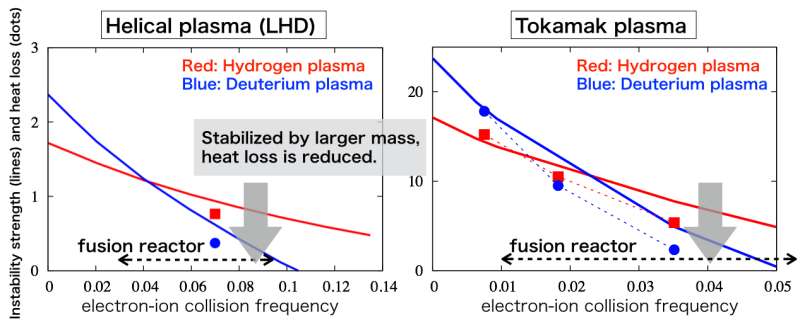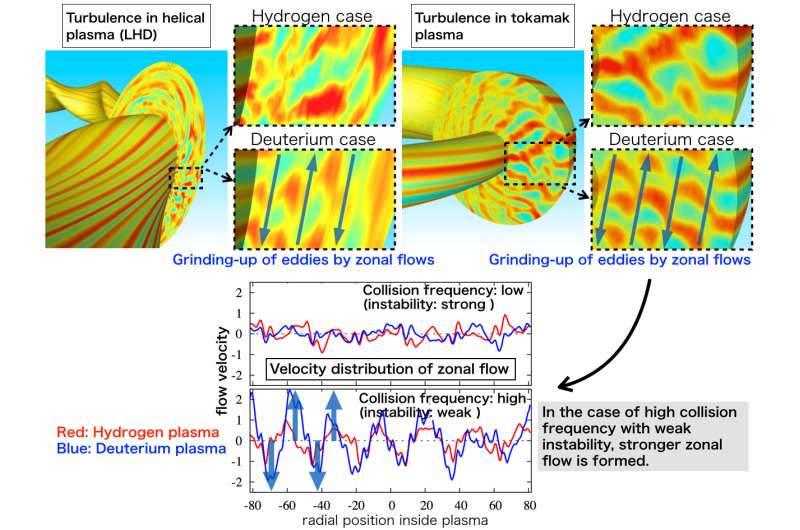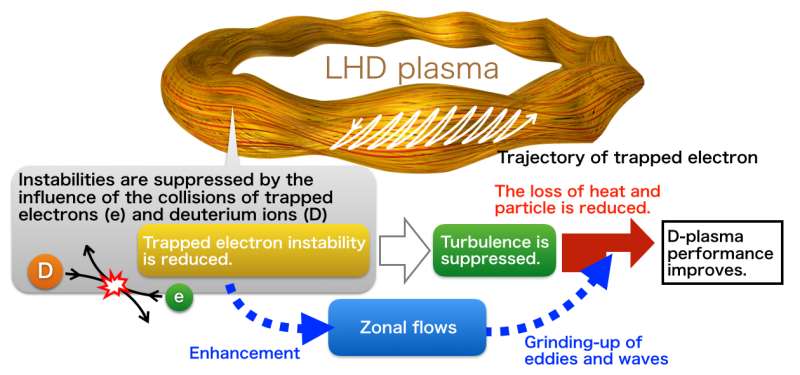Clarifying the mechanism for suppressing turbulence through ion mass

Seeking to further improve plasma performance, from March 7, 2017, plasma experiments utilizing deuterium ions, which have twice the mass of hydrogen, were initiated in the Large Helical Device (LHD) at the National Institute for Fusion Science (NIFS). In numerous plasma experiments being conducted in countries around the world, the use of deuterium is improving the confinement of heat and particles. That is, the phenomenon called "ion mass effect," in which plasma performance is improved, is observed. However, we do not yet understand the detailed physical mechanism of how the increase in ion mass is linked to performance improvement. This has been one of the most important unsolved problems in plasma physics and fusion research from its beginning.
In the plasmas confined in the magnetic field there are various types of waves. In particular conditions those waves grow as time passes, and the so-called "instability" occurs and the plasma becomes turbulent. According to research to date, there has been found to occur a unique flow structure called "zonal flow" that is formed spontaneously in a turbulent plasma. Zonal flows take the stripe structure that flows in the opposite direction to each other, and these flows are known to perform an important role in the suppression of the turbulence. However, there remain many unclarified aspects regarding the conditions by which turbulence and zonal flows are formed. If influences brought about by differences in ion mass can be clarified theoretically, we can accurately predict confinement improvements that are observed in experiments. And because we can link confinement improvement to further enhancement of plasma performance, new developments in research are anticipated.
The research group of Professor Motoki Nakata, through collaborative research with Professor Tomohiko Watanabe of Nagoya University, conducted five-dimensional plasma turbulence simulations utilizing the "Plasma Simulator" at NIFS and the cutting-edge supercomputer "K" at the RIKEN Advanced Institute for Computational Science in order to analyze instabilities (trapped electron modes) caused by electrons that move back and forth along the magnetic field lines and to analyze in detail the turbulence generated from the instability. As a result, we clarified that the influence of the ion mass appeared remarkably in a high-density plasma and that the detailed physical mechanism in which turbulence is suppressed through an effect caused by electron-ion collisions. Further, we discovered that those phenomena exist in both helical and tokamak plasmas. Thus, we were able to clarify the "ion mass effect" broadly observed and one of the important mechanisms to improve plasma performance.

The detailed mechanism that suppresses turbulence is explained below. Turbulence caused due to trapped electron instability weakens the confinement of plasma heat and particles. The collisions among trapped electrons and ions suppress instabilities (suppressing the growth of waves). At a fixed temperature, collisions occur frequently at higher plasma densities. Here, the impacts of collisions in deuterium plasma are remarkable in comparison to hydrogen. As a result, turbulence can be suppressed (Figure 1). Further, we clarified that in the condition in which the instability has weakened, the "zonal flow" becomes stronger and further suppresses the turbulence by grinding large eddies and waves, and eventually improves the confinement of heat and particles (Figure 2).
As has been clarified above, a complete image of turbulence suppression in a plasma with large ion mass may be expressed schematically as in Figure 3. These research results provide fundamental knowledge regarding the complete clarification of the "ion mass effect" which was an unsolved issue for many years in plasma physics and fusion research. Further, the results are anticipated to be beneficial in improving plasma not only in helical devices such as LHD, but also in tokamaks as represented by the International Thermonuclear Experimental Reactor (ITER), which is currently under construction.

More information: Motoki Nakata et al, Isotope Effects on Trapped-Electron-Mode Driven Turbulence and Zonal Flows in Helical and Tokamak Plasmas, Physical Review Letters (2017). DOI: 10.1103/PhysRevLett.118.165002
Journal information: Physical Review Letters
Provided by National Institutes of Natural Sciences




















